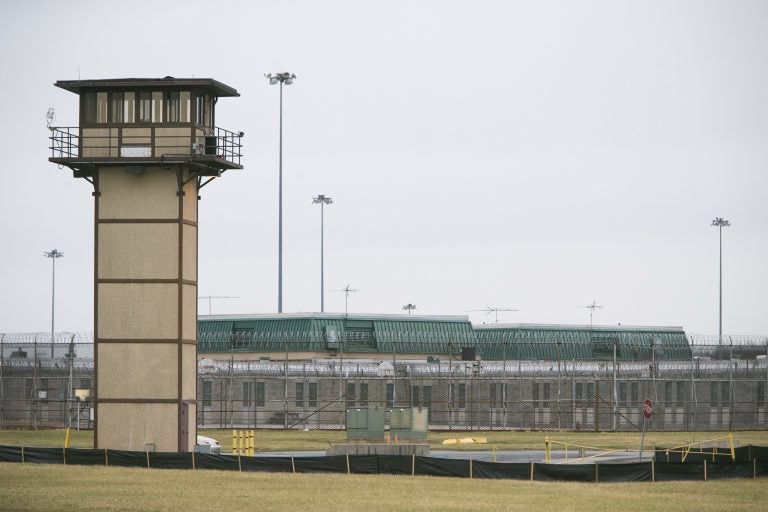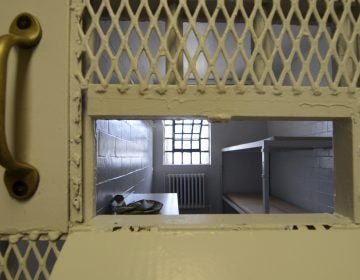Inmate acquitted of guard’s slaying in Delaware prison riot
A jury on Thursday acquitted an inmate accused of leading a riot at Delaware's maximum-security prison during which a guard was killed and other staffers taken hostage.

Vaughn Correctional Center near Smyrna, Del. (Suchat Pederson/The Wilmington News-Journal via AP, File)
A jury on Thursday acquitted an inmate accused of leading a riot at Delaware’s maximum-security prison during which a guard was killed and other staffers taken hostage.
Jurors deliberated over two days before acquitting 32-year-old Roman Shankaras in the death of Steven Floyd. Shankaras recently completed a seven-year sentence for unrelated riot and robbery charges. The verdict paves the way for his release.
Shankaras is one of 18 inmates indicted after the 2017 riot, 16 of whom were charged with murder in Floyd’s death. Two guards were released by inmates after being beaten and tormented. A female counselor was held hostage for nearly 20 hours before tactical teams burst in and rescued her.
Two other trials against seven inmates resulted in only one murder conviction.
The verdict against Dwayne Staats, who was already serving life for murder, came after he openly admitted in court that he planned the riot, knowing it could become violent. Another inmate, Kelly Gibbs, killed himself in November, just days after pleading guilty to rioting, kidnapping, and conspiracy.
One of Staats’ co-defendants in the first trial, Jarreau Ayers, was acquitted of murder but convicted along with Staats of assault, kidnapping, conspiracy and riot. The jury acquitted a third co-defendant, Deric Forney, on all charges.
The second trial ended last month with no convictions for any of the four defendants. Prosecutors subsequently dismissed cases against six of the remaining inmates, opting to move forward only against Shankaras and two others.
With little physical evidence, and no surveillance camera footage, prosecutors have relied heavily on testimony from other inmates, whose credibility has been successfully attacked by defense attorneys.
The prosecution’s star witness in all the trials has been former Baltimore gang leader and convicted murderer Royal Downs.
Downs, who is serving a life sentence, has claimed repeatedly that he advocated for a peaceful protest by inmates to air grievances about their treatment, perhaps by staying in their cells and refusing to come out. Once the riot broke out, however, Downs became a key player, taking a walkie-talkie from another inmate and participating in hostage negotiations with law enforcement officials.
Despite his role in the riot, Downs was among several inmates allowed to leave the building during the siege. He signaled his willingness to cooperate with authorities even before the riot was over and subsequently was allowed to plead guilty to a single count of riot, which carries no mandatory prison time, in exchange for testifying against other inmates.
On the witness stand, Downs described Shankaras as the “puppet master” of the uprising.
Defense attorney Patrick Collins argued that Downs, Staats and Ayers were the true leaders of the revolt. He described Downs as an authority figure among fellow inmates with a history of getting others to do his bidding, including duping Shankaras into writing two letters to him two months after the riot.
Shankaras testified that he wrote the letters after being told to do so by Downs, who indicated he was going to shoulder the blame for the riot and needed information to bolster his credibility. Unbeknownst to Shankaras, Downs was cooperating with investigators.
In the first letter, Shankaras described details of the riot, some of which turned out to be inaccurate because, according to Collins, they were based not on what Shankaras saw or did, but what he heard from other inmates. The second, more damning letter, reads like a manifesto and notes that “persistence procreated the resistance.”
“Some had to be convinced, some had to be tricked, and others had to be forced,” Shankaras wrote.
Collins argued that Downs drafted the manifesto and duped Shankaras, out of fear, into copying it in his own handwriting, so that Downs could use it as “insurance” in his cooperation and plea negotiations with prosecutors.
WHYY is your source for fact-based, in-depth journalism and information. As a nonprofit organization, we rely on financial support from readers like you. Please give today.


